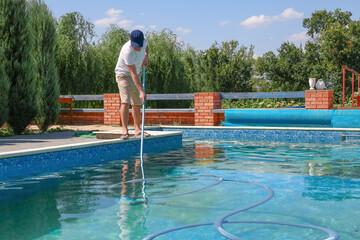
A clean pool is more than just visually appealing—it is essential for health, safety, and enjoyment. Pools collect debris, dirt, and bacteria quickly, especially when used often or exposed to outdoor elements. Learning how to clean your pool properly ensures crystal-clear water, prevents costly repairs, and extends the life of your pool. With consistent care and the right techniques, pool maintenance can be simple and rewarding.
Why Cleaning Your Pool Is Important
Regular pool cleaning prevents algae growth, keeps the water safe for swimming, and ensures that the filtration system functions efficiently. Dirty or unbalanced pools can cause skin irritation, eye discomfort, and even health concerns if bacteria and contaminants are left untreated.
Beyond health, proper cleaning preserves pool equipment. Pumps, filters, and liners last longer when debris and buildup are removed regularly. A well-maintained pool also enhances the beauty of outdoor spaces, making them more inviting for family and guests.
Essential Tools for Pool Cleaning
Before diving into maintenance, having the right tools makes the process easier and more effective. Common cleaning essentials include:
- Pool skimmer net – Removes leaves, insects, and floating debris.
- Pool brush – Cleans walls, steps, and tile lines.
- Vacuum – Sucks up dirt and debris from the bottom of the pool.
- Water testing kit – Monitors chemical levels to keep water balanced.
- Pool filter system – Keeps water circulating and free from contaminants.
With these tools, maintaining a pool becomes manageable and less time-consuming.
Step-by-Step Guide to Cleaning Your Pool
1. Skim the Surface Daily
Leaves, bugs, and debris should be removed daily with a skimmer net. This prevents them from sinking to the bottom, where they are harder to clean. Regular skimming also keeps the water looking clear and fresh.
2. Brush the Walls and Floors
Algae and dirt often stick to pool walls, steps, and tiles. Using a pool brush at least once a week prevents buildup and keeps surfaces smooth. Pay special attention to corners and hard-to-reach spots where algae tend to grow.
3. Vacuum the Pool
Vacuuming removes debris that has settled at the bottom of the pool. Depending on the type of vacuum, this may be a manual or automatic task. Weekly vacuuming ensures dirt does not accumulate and affect water clarity.
4. Check and Clean the Filter
Filters are the heart of pool cleanliness. Whether it’s a cartridge, sand, or diatomaceous earth filter, it needs to be cleaned regularly to work efficiently. A clogged filter reduces circulation, leading to cloudy water. Clean or backwash filters as recommended for your system.
5. Test and Balance Water Chemistry
Healthy pool water requires balanced chemical levels. Testing kits measure pH, chlorine, alkalinity, and calcium hardness. Aim for a pH between 7.2 and 7.6, and ensure chlorine levels are adequate to sanitize the pool. Balancing chemicals prevents algae, keeps water clear, and protects equipment.
6. Shock the Pool Periodically
Shocking the pool involves adding extra chlorine or other sanitizers to kill bacteria and algae. This is especially important after heavy use, storms, or when the water looks cloudy. Regular shocks keep the pool safe and sparkling.
7. Maintain Water Levels
Evaporation, splashing, and rain affect pool water levels. Keeping water at the proper height ensures the pump and filter system function correctly. Low water levels can damage equipment, while high levels reduce skimming efficiency.
Preventing Common Pool Problems
Consistent maintenance helps avoid common pool issues such as cloudy water, algae blooms, or unpleasant odors. Here are a few preventive tips:
- Circulate water daily – Running the pump helps prevent stagnant water where bacteria thrive.
- Store chemicals properly – Keep pool chemicals in a cool, dry place and away from direct sunlight.
- Cover the pool when not in use – Covers reduce debris, maintain water temperature, and lower cleaning frequency.
- Inspect equipment regularly – Check pumps, hoses, and filters for signs of wear or damage.
By addressing small issues early, you can avoid larger, more expensive repairs.
Seasonal Pool Cleaning Tips
Spring Opening
When reopening your pool after winter, remove the cover carefully, clean out debris, and shock the pool to restore safe water conditions. Inspect all equipment before starting the season.
Summer Maintenance
During peak swimming season, increase cleaning frequency. Test water chemistry at least twice a week and skim daily. With more swimmers, pools require extra attention.
Fall Care
Leaves and debris are more common in the fall. Skimming and vacuuming become more frequent. Preparing the pool for winter may involve lowering the water level, cleaning thoroughly, and covering securely.
Winterizing
In colder climates, pools should be properly winterized to prevent damage. This includes draining water from pipes, cleaning the pool, and using a durable cover.
Health Benefits of a Clean Pool
A clean pool is not just visually pleasing—it supports health and safety. Properly maintained water reduces exposure to harmful bacteria and prevents skin and eye irritation. Swimming in clear, balanced water also makes the experience more enjoyable and relaxing.
In addition, pools can provide low-impact exercise, stress relief, and quality family time, all of which are enhanced when the water is clean and inviting.
Learning how to clean your pool is an essential part of responsible ownership. With the right tools, regular maintenance, and attention to water chemistry, your pool can remain a safe and refreshing retreat all year long. From skimming and brushing to vacuuming and balancing chemicals, each step contributes to clear water and a healthier swimming environment.
By staying consistent and addressing issues early, you’ll not only protect your investment but also create a space for relaxation, exercise, and fun. A sparkling pool is the reward of proper care, and with these simple steps, you can keep it that way for years to come.